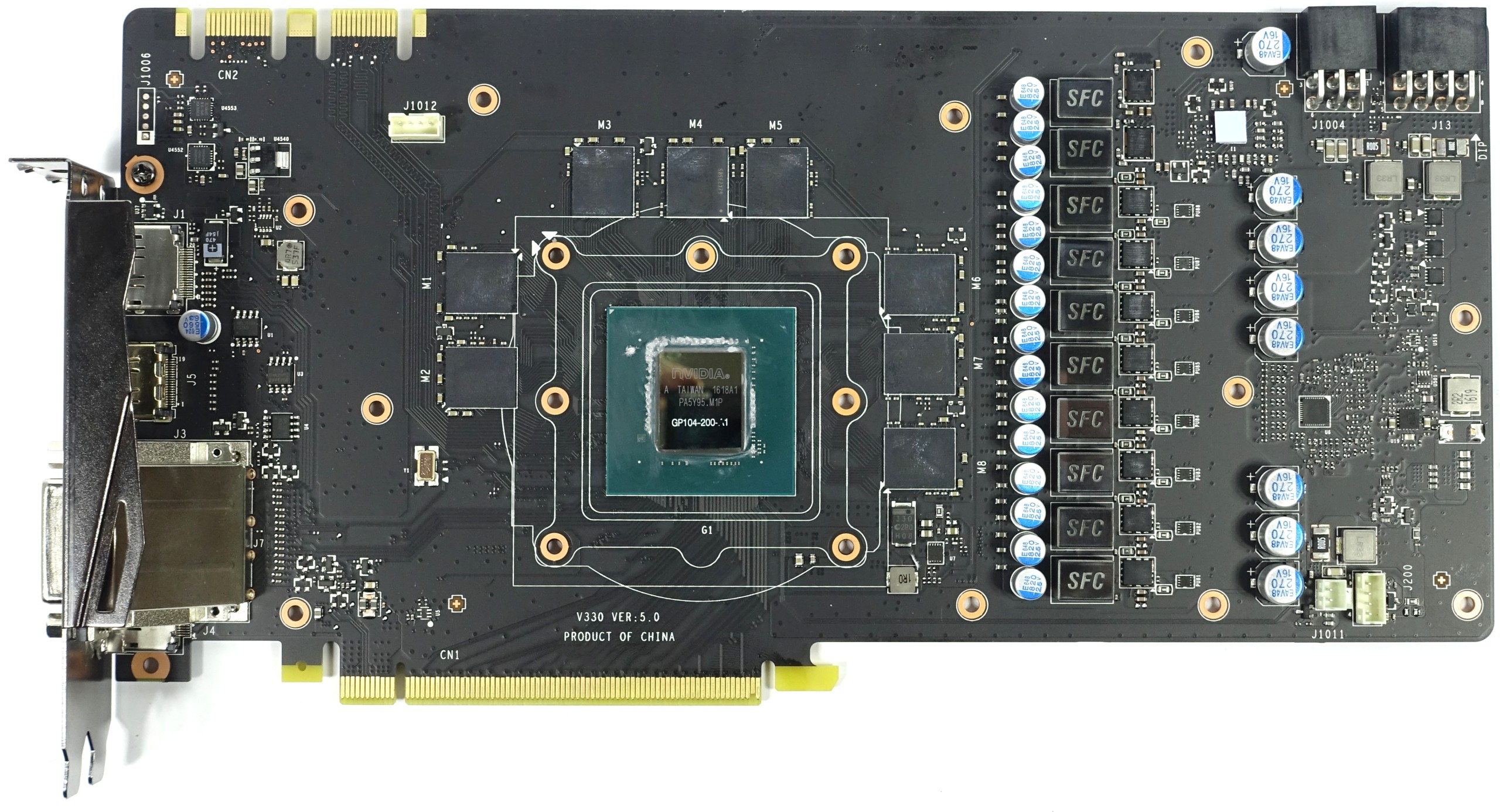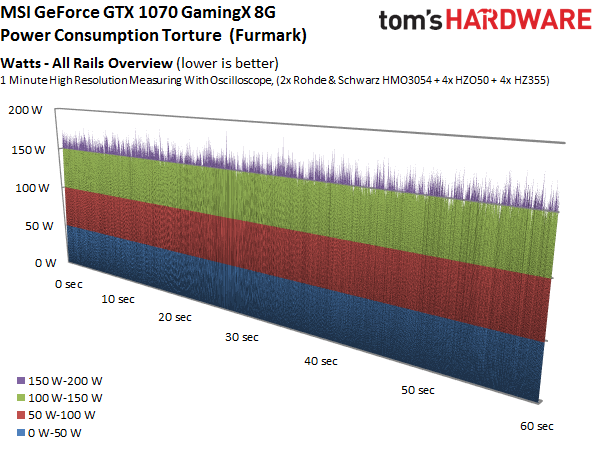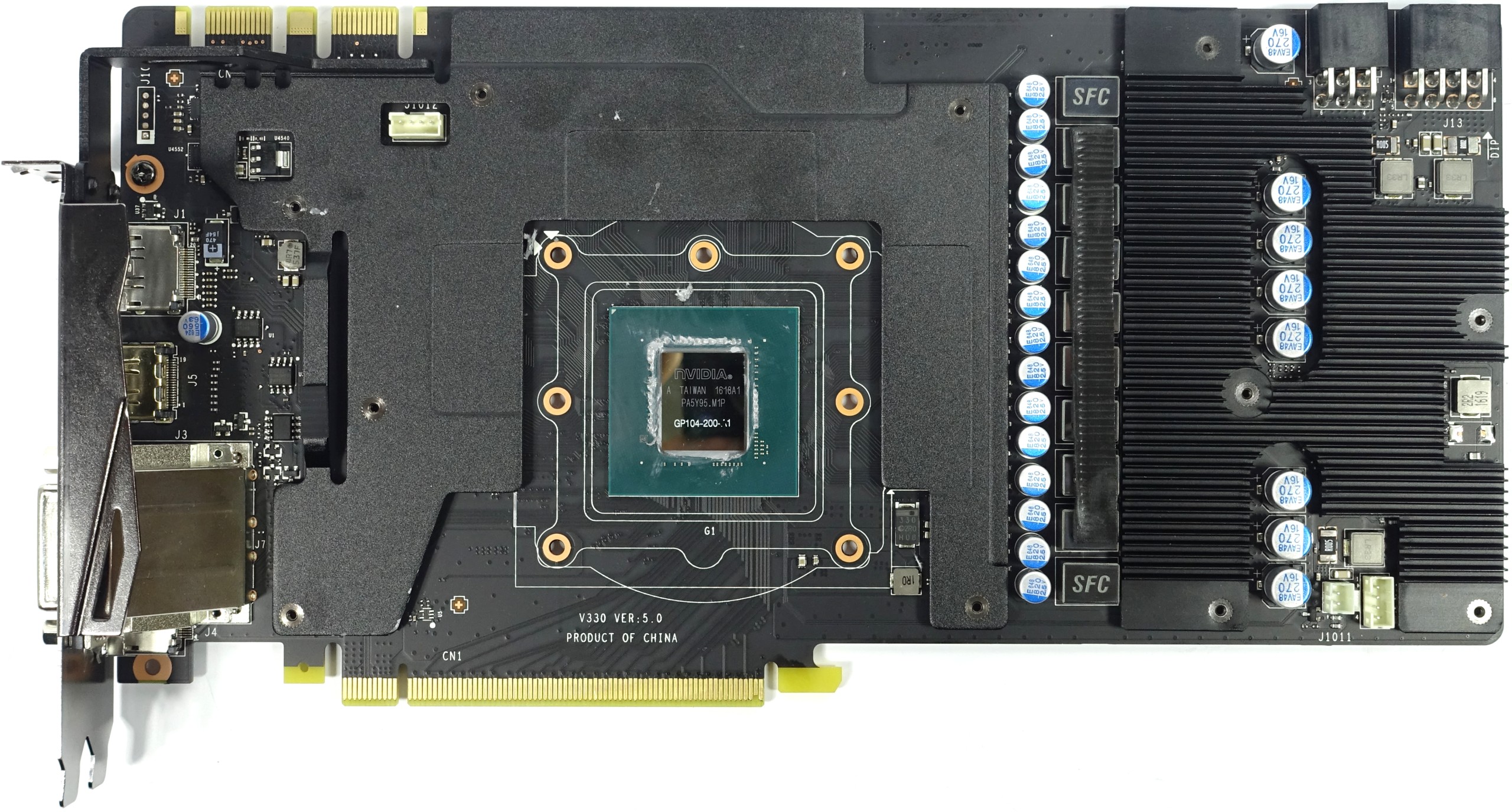Nvidia GeForce GTX 1070 Graphics Card Roundup
MSI GTX 1070 Gaming X 8G
Why you can trust Tom's Hardware
MSI managed to build a reputation for itself with the Gaming series, and its GeForce GTX 1070 Gaming X 8G strives to live up to high expectations set by those predecessors. The coming employs a conservative default clock rate and a good-enough, low-noise cooler.

There's a higher-end family called Lightning in MSI's portfolio, so it remains to be seen how much the manufacturer held back to create the more mid-range Gaming X version. At the same time, this also isn't MSI's entry-level GeForce GTX 1070. That distinction goes to the simpler Armor 8G and Aero 8G.
We're testing a press sample of the Gaming X with a non-standard firmware, as it turns out. In this version, the OC mode is active by default, resulting in a ~20 MHz-higher core and GPU Boost clock rate. In practice, the differences between this card and the retail one are negligible, so we didn't re-flash the BIOS for our tests. Instead, we switched back to the standard mode via vendor-supplied software. Thus, the GPU's frequency in our benchmarks is still equivalent to the retail model.
Technical Specifications
MORE: Best Graphics Cards
MORE: Desktop GPU Performance Hierarchy Table
MORE: All Graphics Content
Exterior & Interfaces
MSI's fan shroud is made of relatively thin plastic, though it's mounted on a large frame for improved stability. Weighing in at 1080g, this card isn't particularly light. It's 28.4cm long, 13.5cm tall, and 3.5cm wide, similar to most dual-slot cards. The rotor blades of the double ball bearing fans have a diameter of 95mm.


The back of the board is covered by a single-piece plate with some holes for ventilation, but it doesn't contact the PCB through thermal pads and consequently does nothing for cooling. Unfortunately, this backplate makes it necessary to plan for an extra 5mm of clearance behind the card, which may be relevant in multi-GPU configurations.
Using the card without its backplate proved difficult due to integrated spacers. Furthermore, the screws attaching the backplate have threaded portions that are too short to secure the frame and VRM cooler once the plate is gone. That's why we had to abstain from running the card without its backplate, limiting our view during the IR temperature testing.
The top of the card is dominated by an illuminated MSI logo and three visible heat pipes (two 6mm and one 8mm). Six- and eight-pin auxiliary power connectors are positioned at the end of the card and rotated by 180°. MSI's black and red color scheme should be familiar by now, similar to the card's shape.


An open end reveals horizontally-oriented fins, which channel airflow towards the card's front and back. This is an advantage since a lot of heated air exhausts out the slot cover. What remains isn't directed out the top, close to your CPU. Although we like centrifugal coolers able to blow everything out the back, this is a next-best solution.


The slot plate features five display outputs, of which a maximum of four can be used simultaneously in a multi-monitor setup. In addition to one dual-link DVI-D connector, the bracket also hosts one HDMI 2.0b port and three DisplayPort 1.4-capable interfaces. The rest of the slot plate is dotted with openings for airflow.
Shedding that often-unused DVI connector would have made room for even more ventilation, which may have helped the cooling solution's effectiveness. Ah well.
Board & Components
A glance at the board reveals a well-arranged layout. It uses eight Samsung K4G80325FB-HC25 modules, each able to store up to 8Gb (32x 256Mb). Each chip operates at voltages between 1.305 and 1.597V, depending on the selected clock frequency.

The 8+2-phase power subsystem relies on the sparsely documented µP9511P for PWM control. However, unlike Nvidia's Founder Edition card, the controller is placed on the front rather than the back. Since this controller can't communicate directly with the VRM's phases, MSI utilizes gate drivers to talk to the dual-channel MOSFETs. And because MSI is using dual- rather than single-channel MOSFETs, it can use space on the PCB more efficiently. The company also goes with Super Ferrite Chokes, which are a bit classier than what you typically find on reference designs.

Two capacitors are installed right below the GeForce GTX 1070 Gaming X's GPU to absorb and equalize voltage peaks.
Power Results
Before we look at power consumption, we should talk about the correlation between GPU Boost frequency and core voltage, which are so similar that we decided to put their graphs one on top of the other. This also shows that both curves drop as the GPU's temperature rises.

After warm-up, GPU Boost frequencies fall as low as 1962 MHz under load. This is mirrored by our voltage measurements. While we observed up to 1.062V in the beginning, just like Nvidia's Founders Edition, that value drops to 1.05V later on.

Combining the measured voltages and currents allows us to derive a total power consumption we can easily confirm with our instrumentation by taking readings at the card's power connectors.
As a result of restrictions imposed by Nvidia, whereby the lowest attainable frequencies are sacrificed to hit higher GPU Boost clock rates, the power consumption of many factory-overclocked cards is disproportionately high when they're idle. This one can only go as low as 253 MHz. The following table shows what impact that has on our measurements:
| Idle | 16W |
|---|---|
| Idle Multi-Monitor | 17W |
| Blu-ray | 18W |
| Browser Games | 103-127W |
| Gaming (Metro Last Light 4K) | 181W |
| Torture (FurMark) | 177W |
These charts go into more detail on power consumption at idle, during 4K gaming, and under the effects of our stress test. The graphs show how load is distributed between each voltage and supply rail, providing a bird's eye view of load variations and peaks.












Temperature Results
As it pertains to cooling, MSI has a lot to offer. Its sturdy frame covers almost all of the PCB not already covered by heat sinks for the VRMs.

Thermal pads between the memory modules and frame, along with the voltage regulators and cooling plate, provide the interfaces needed to transfer heat away from those areas. However, we would have liked thinner and more efficient design, since fan speeds (and thus airflow) are rather low.
The massive cooler has horizontally-oriented fins as well as four nickel-plated 1/4-inch (6mm) copper heat pipes, plus an 8mm one. The direction they face is more or less irrelevant since they consist of sintered composite material, relagating unreliable axial grooves or meshes to ancient history. MSI furthermore relies on a massive nickel-plated heat sink.

A rather restrictive 149°F (65°C) temperature target does result in the fans reacting faster with a shorter start-up time. But this is unfortunately foiled by their throughput and maximum required speed.

Since we couldn't test the GeForce GTX 1070 Gaming X 8G without its backplate, we had to take our measurements with that cover in place. On the bright side, one of the plate's ventilation openings is right above a memory module positioned between the VRMs and GPU. The measured 176°F (80°C) is acceptable.

Temperatures actually dropped during our stress test, since the card throttled back its clock rate, lowering power consumption.

Sound Results
Since the temperatures during our gaming and torture workloads are similar, the observed fan speeds are about the same as well. The start-up behavior and well-implemented hysteresis, which prevents multiple on/off cycles once the fans start spinning, is clearly visible.
In addition, the start-up speed is chosen in such way that the fans will certainly continue to start reliably, even as they age. The same goes for when the fans turn off.

When the card is idle, there is no noise thanks to its semi-passive mode. Naturally, there's no need to take acoustic measurements.
Running at full load barely raises the noise level to 33 dB(A). This value doesn't go any higher, even during our torture test. The card is so quiet that we were able to measure >5 kHz frequencies coming from the voltage regulators, which most people would barely be able to hear. It's only when the GeForce GTX 1070 Gaming X 8G cranks out frame rates in the hundreds that you hear the VRMs chirp a little louder.

It seems like the cooler is almost overkill for its job. On the other hand, we prefer being safe to sorry. MSI obviously does a good job.
MSI GTX 1070 Gaming X 8G
Reasons to buy
Reasons to avoid

MORE: Best Deals
MORE: Hot Bargains @PurchDeals
Current page: MSI GTX 1070 Gaming X 8G
Prev Page Gigabyte GTX 1070 Mini ITX OC Next Page Palit GTX 1070 GameRock Premium EditionStay On the Cutting Edge: Get the Tom's Hardware Newsletter
Get Tom's Hardware's best news and in-depth reviews, straight to your inbox.
-
adamovera Archived comments are found here: http://www.tomshardware.com/forum/id-3283067/nvidia-geforce-gtx-1070-graphics-card-roundup.htmlReply -
TheRev MasterOne Asus ROG Strix GeForce GTX 1070 and Gigabyte GeForce GTX 1070 G1 Gaming pics are switched ! Did I win something? a job?Reply -
eglass Disagree entirely about the 1070 being good value. It's the worst value in the 10-series lineup. $400 for a 1070 is objectively a bad value when $500 gets you into a 1080.Reply -
adamovera Reply
The filenames of the images are actually swapped as well, weird - fixed now, thanks!19761809 said:Asus ROG Strix GeForce GTX 1070 and Gigabyte GeForce GTX 1070 G1 Gaming pics are switched ! Did I win something? a job? -
barryv88 Are you guys serious!?? You recommend a 1070 card that costs $530 which isn't even available in the U.S? That sorta cash gets you a much quicker GTX 1080! The controversy on this site is just non stop. If your BEST CPU's list wasn't enough already...Reply -
bloodroses I wonder how the Gigabyte 1070 mini compares to the other mini cards like the Zotac and MSI unit?Reply -
adamovera Reply
This is a roundup of all the 1070's we've tested. The graphics card roundups originate with our German bureau and are re-posted in the UK, so they'll sometimes include EU-only products - I'm guessing they're appropriately priced to the competition in their intended markets.19761907 said:Are you guys serious!?? You recommend a 1070 card that costs $530 which isn't even available in the U.S? That sorta cash gets you a much quicker GTX 1080! The controversy on this site is just non stop. If your BEST CPU's list wasn't enough already...
The Palit received the lowest level award - the Asus, the MSI, and one of the Gigabyte boards are better options. -
JackNaylorPE Reply19761822 said:Disagree entirely about the 1070 being good value. It's the worst value in the 10-series lineup. $400 for a 1070 is objectively a bad value when $500 gets you into a 1080.
The 1080 , like it's predcessors (780 and 980) has consistently been the red headed stepchild of the nVidia lineup. So much so that nVidia even intentionally nerfed the performance of the x70 series because its performance was so close to the x80.
The 1080 has dropped in price because, sitting as it does between the 1080 Ti and the 1070... it doesn't exactly stand out. When the 780 Ti came out, the price of the $780 dropped $160 overnight, so much so that I immediately bought two of them and the two sets of game coupons knocked $360 off my XMas shoping list. At a net $650, it was a good buy.
Using the 1070 FE as a reference and the relative performance data published by techpowerup for example.....Used MSI Gaming model since it is one model line where TPU reviewed all 3 cards
The $404 MSI 1070 Gaming X is 104.2% as fast as the 1070 FE
The $550 MSI 1080 Gaming X is 128.2% as fast as the 1070 FE
The $740 MSI 1080 Ti Gaming X is 169.5% as fast as the 1070 FE
So the cost per dollar for comparable quality designs is:
MSI 1070 Gaming X = 104.2 / $404 = 0.258
MSI 1080 Gaming X = 128.2 / $550 = 0.233
MSI 1080 Ti Gaming X = 169.5 / $740 = 0.229
Even at $500 .. the 1080 only comes in 2nd place at 0.256, so no, the better value argument doesn't hold, even assuming we were getting an equal quality card.
Looked at other comparable as a means of comparison and they are for the most par equal or higher ....
Strix at $420, $550 and $780
AMP at $435, $534 and $750
Now with any technology, eeking those last bits of performance out anything always comes at a increased cost. You more of a cost premium going from Gold to Platinum rating on a PSU than you do from Bronze to Silver of even Gold. It's simply another example of Law of Diminishing Returns. So we should expect to pay more per each performance gain with each incremental increase and that hold here. You'd expect that for each increase in performance the % increase in price per dollar would get bigger. But the x80 is quite an aberration.
We get a whopping 10.7 drop of 0.025 from the 1070 to the 1080
We get a rather teeny 1.7 drop of 0.004 from the 1080 to the 1080 Ti
Therefore, logically.... you are paying a 10.7% cost penalty for the increased performance to move up to from the 1070 to 1080 ... whereas the cost penalty for the increased performance to move up to from the 1080 to 1080 Ti is only 1.7% This is why eacxh time the Ti has been introduced, 1080 sales have tanked.
Another way t look at it...
1070 => 1080 = 23% performance increase for $146 ROI = 15.8%
1080 => 1080 Ti = 32% performance increase for $190 ROI = 16.8 %
It's not a matter **if** you can get **a** 1080 at $500., it's whether you can get the one you want. How is it that the $550 models have more sales than the less expensive ones ? Some folks don't care about noise, some folks don't OC, some folks hope they will be able to get the full performance available to us **if** someone ever comes out with a BIOS editor. And yes, there will cards that are heavily discounted for any number of reasons ... low factory clock, noise or heat concerns , some have taken some hits from bad reviews or are discounted simply because sales are poor .... but if a card is selling well below the average price it is because it's not as well made or just isn't selling for real or imagined issues. (example being EVGA SC / FTW ACX designs are now fixed but but EVGA still has a black eye from the earlier cooler problems and if buying EVGA, peeps want iCX. Finally, the 1080 bears the burden of being compared with the 780 and 980 whicc again got lost between the higher / lower cards.
Given the above ROI numbers, I am surprised that all the 1080s have not dropped below $500. But to my eyes, the `080 only starts to make sense when the cost is below $520 and **the ones I'd buy** just aren't there yet
-
Adroid Yea I refuse to buy a 1070 because they are overpriced, period. I almost bought a 1080 but judging from the performance difference it simply wasn't worth it, either. There is not much a 1080 will do that a 1070 won't. What I mean is - a 1060 will run 1080p fine. With that in mind, a 1080 gives very marginal benefit at 2k, and neither one will run 4k smoothly - so what's the point.Reply
If the 1080 was a 350$ card, I might have bit, but as it stands now I'll be waiting for the 1080ti to drop a bit, which can run most games in 2k over 120fps - and justifying an upgrade from a GTX 700 series card. I'm not going to pay over $400 for a card that won't smoke my GTX 770... I can play all games on moderate settings now, so I want ultra settings at 2k that make use of a 144hz monitor - or bust. -
tyr8338 I`m using gigabyte 2 fan 1070 for over a year now and it`s really good, it`s good overclocker and is running at 1974 mhz overclock 24/7 and 8600 on ram, probably it would be able to go even higher but it`s fine for me :) It`s quiet but at around 50% fan speed it produces some strange vibration sound sometimes, it dosn`t bother me all that much tbh but it can be a little annoying.Reply